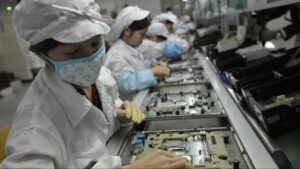This past October there was an outbreak of COVID-19 at the Foxconn factory in Zhengzhou in China, the largest complex that produces iPhones for Apple, which houses different production plants. At the time, a spokesperson for Apple’s supplier said the impact was manageable and conditions at the factory were stable. However, the company prioritized maintaining production, rather than protecting workers from the outbreak. This unleashed further contagion, to which the company responded with very strict confinement measures.
On Monday, November 7, The Wall Street Journal published a report based on interviews with more than two dozen Foxconn workers and their family members, and the company’s announcements on its WeChat account.
Employees alleged that they began to comply with quarantine on October 7, and that they could not leave their production unit for 27 hours, until they were transferred to a new block of bedrooms in the complex, where they were quarantined for a few days. The workers complained about the lack of food and medicine supplies for the infected people. The situation reached such a point that, on October 28, many decided to leave the factory, on their own feet or using government buses to take them home. Foxconn offered five incentives for people who changed their minds and went back to work.
The iPhone manufacturer has not disclosed the number of COVID cases that have occurred. The company reportedly downplayed the dangers of contracting the virus, sharing statements from medical experts on the female workforce.
Some people did not believe that people returning to work after quarantine had still tested negative. Instead, one rumor claimed it was a plan to mix COVID patients with healthy people to promote herd immunity.
This episode highlights the tension between the need to continue bussiness activities and China’s desire to maintain the 0 COVID-19 policy. In much of the world, it seems that the COVID-19 pandemic is already winding down, but in China the situation is not yet back to normal.

A petition of signatures has been organized calling for Apple to take its responsibility to fully investigate the incident at Foxconn’s Zhengzhou factory. We ask these questions to be answered under an independent investigation authorized by Apple:
-
In mid-October, outbreaks occurred at the factory, creating harsh conditions that affected even those who were not infected. Why did Foxconn wait until October 30 to acknowledge this? What was Foxconn hiding, and why?
-
How many Foxconn workers contracted COVID-19 in October?
-
How many Foxconn workers died in October? What are the causes of death?
-
Who authorized the order prohibiting the workers from leaving the factory in October? What was the reason?
-
Why were the infected workers not given medical supplies?
-
Why were there cases in the distribution of essential products in the factory area?
-
What were Foxconn’s standards for housing conditions for workers during lockdown? How many people were isolated in October?
-
Why weren’t there enough isolation areas equipped with adequate basic supplies for workers?
-
How many temporary workers does the Zhengzhou Foxconn factory currently hire? Why don’t they have another type of contract?
-
Is there evidence of forced labor during the closed loop production period?
-
Are there workers whose movements have been forcibly restricted during the closed circuit production period? Who were the people who implemented these policies?
Sign the petition here!
Sources:
- The Wall Street Journal – Apple iPhone Assembler Tried to Ease Worker Fears About Covid—It Led to a Tighter Lockdown
- The Guardian – China braces for wave of workers fleeing iPhone factory in Covid-hit Zhengzhou
- AppleInsider – Foxconn reportedly downplayed severity of recent COVID outbreak
- Reuters – EXCLUSIVE Output of Apple iPhones at major China plant could fall 30% amid COVID curbs -source
Videos:
- China Insights – Zhengzhou Foxconn Factory: 10,000+ workers flee covid lockdown/Apple iPhone Production Plunges
China Insights – Zhengzhou Foxconn workers keep on fleeing and now China locks down area around ‘iPhone city’

